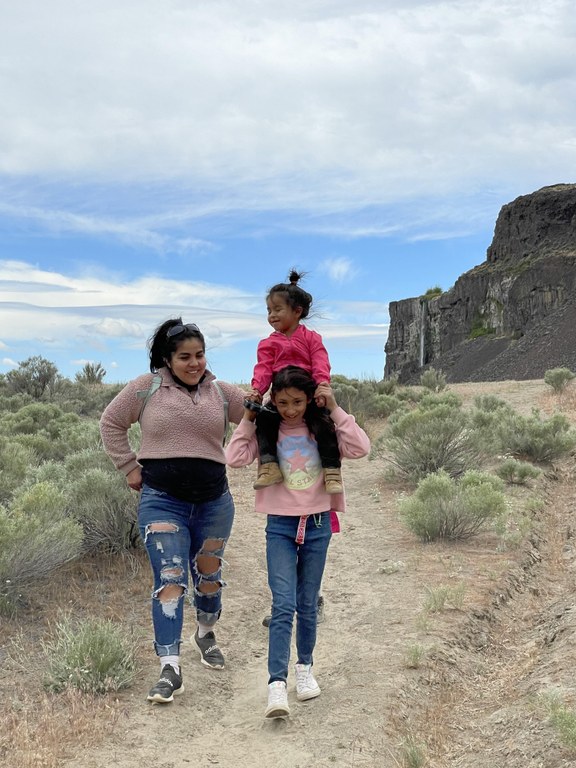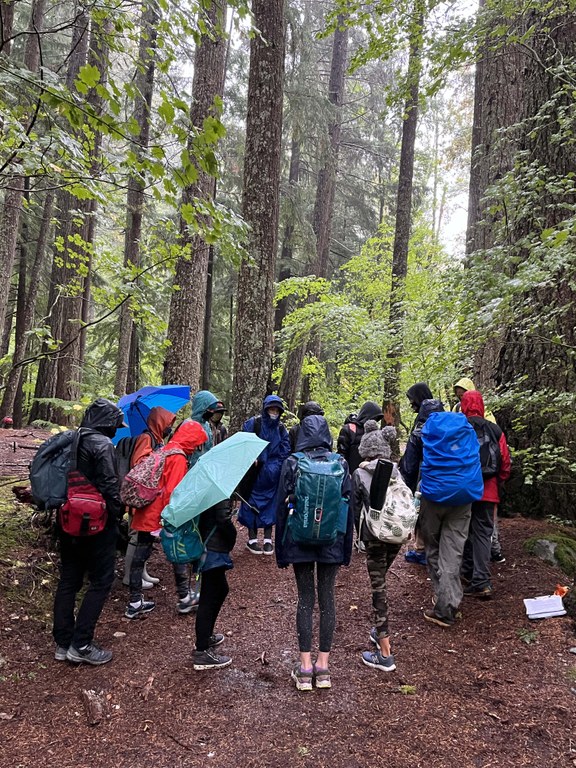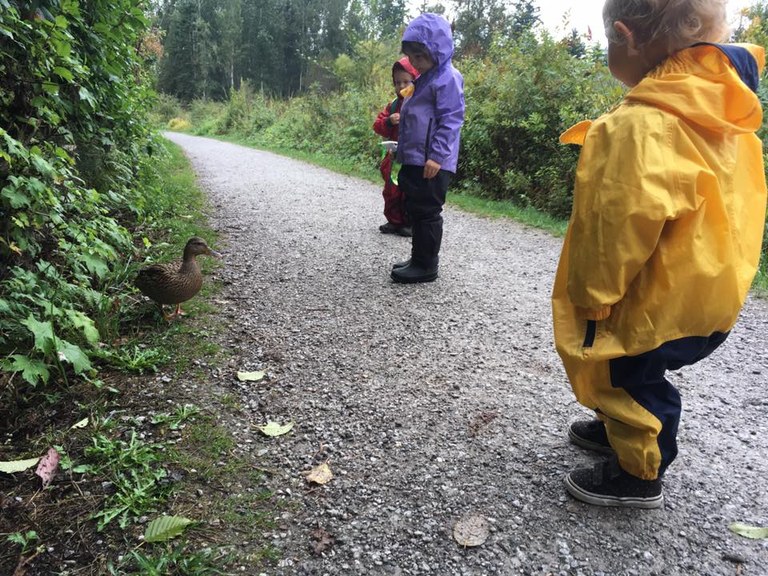Expert Tips for Getting Outside with Kids
By Jessi Loerch
“One of the things I said every day when the kids came was ‘it’s a beautiful day.’ It could be raining biblically outside and I would say ‘It’s a beautiful day.’ And truly, it would be,” said Khavin Debbs, the deputy executive director of Tiny Trees outdoor preschool.
As an educator, Khavin has plenty of experience getting kids outside — and he believes deeply that that time is important for the kids, and for their grown ups. As the weather turns rainier and wetter, it can feel a little daunting to keep getting outside with the kids in your life. But, if you can figure out a way to make it easy and fun, your whole family will feel the benefits of a chance to relax, play and just enjoy the simple beauty of being outdoors.
We talked to Khavin and other professionals who work with kids and families regularly to hear some of their top tips for getting outside, as well as why it’s worth it. Here’s what they had to say.

Embracing wet trails. Photo by Rebekah Emrich.
Dress ‘em like ducks: To love the rain, shed water and stay warm
It’s a reality of life in the Northwest. We get a lot of rain and, in some places, a lot of snow. Dressing yourself and your kids to stay warm and comfortable can make all the difference when you head outside.
Khavin knows that gear can be a barrier, because it can be expensive, so he encourages looking at thrift or consignment stores to find outdoor gear. He says that, when he checks the thrift store near him, he regularly finds affordable clothes that would work great to keep kids warm and dry. Look for an underlayer, like fleece or similar, that can withstand a bit of moisture. And look for an outer layer (rain coat, etc.) that will keep everyone dry.
He also reminds the grown ups to keep in mind their own gear. If you’re miserable, your kids won’t have fun, either.
Holly Roger, community programs coordinator and mentor at Wild Whatcom, says that kids love to get outside in the rain. Puddle jumping is a time honored tradition, after all. If you have a kid who really loves it, she suggests checking out fishing stores for super-waterproof gear. She also recommends thinking about other items beyond clothing. She loves waterproof field guides — the tri-fold ones that are really simple and visual — which can often be found a local bookstores or nature stores.
Kids also love to touch things — even if they're wet. So being prepared with waterproof gloves or mittens can go a long way. This can be especially important if kids are new to getting outside when it's cold or wet — you don't want them to have a bad experience.
“If your hands are cold, you can be pretty miserable,” said Jean Bartholomew, WTA’s Outdoor Leadership Training manager. “So having warm hands allows you to experience the trip and decide if you even enjoy it or not.”

Photo courtesy Team Naturaleza.
Leave them wanting more
Elisa Lopez is the project director for Team Naturaleza, which works to create connections between the Latino and Hispanic community in Wenatchee and the outdoors. They offer bilingual environmental education and events to people of all ages.
Elisa says that one thing she always keeps in mind with her events is to “leave them wanting more.” When she finishes a hike or event, she wants people to leave and be excited to come back and do more.
“We want to create positive memories in the outdoors so they will want to come back,” she said.
That can mean keeping to shorter trails, especially at first. For families going out with kids, that might mean only going as far as a cool tree across the street.
Learning together
Alexa Brandt, senior program instructor at the North Cascades Institute (NCI), spends summers working with folks of all ages through NCI’s summer programs. One of her favorites is their Family Getaways, which center intergenerational learning through hands-on lessons and activities.
“Watching grandparents learn from grandchildren, for example, and vice versa, is such a beautiful thing and it encourages important perspective sharing while deconstructing the idea that adults are the holders of all knowledge,” she said.
When getting outside with your kids, remember that you can learn just as much from them as they can from you. (And you don’t have to force learning. Just being outside is good for your brain — and you and your kids are learning whether you actively realize it or not.)
Elisa’s Team Naturaleza’s programs, which are offered in both Spanish and English, also give a way for kids and adults to learn together. When Elisa was young, she remembers going on field trips or visiting trails. She was excited about what she learned, but it was hard to talk about to her parents, who didn’t speak English. They had plenty of outdoor knowledge, but a lack of shared vocabulary made it difficult to have a discussion. Sharing learning in two languages helps break down that barrier for the people on Team Naturaleza’s trips.
Why go outside?
For Khavin, who mostly works with kids in the preschool age, student-directed learning is really important

Photo courtesy North Cascades Institute.
“It’s all about setting up the environment so the child wants to explore and the teacher is less of a teacher and more of a guide of that knowledge,” he said. “That student-led education really lends itself to the outdoors. There’s so much happening — leaves change, Indian plum blooms, mushrooms, trees to climb, a slug in the road. There are just so many activities and it’s very organic.”
So, time outside is a powerful way for kids to learn. But it’s also a way to just improve the mental and physical health of the whole family
“Biologically, I think we are wired to be an outside species,” Khavin said. “Getting to do that on a more regular basis builds an equilibrium and homeostasis with the natural environment that is really important.”
Jean knows that time outside can really help us all get through the darkness of winter.
"Especially getting out and having play time in the snow is so special. Even if you intend to to snowshoe but all you do is have snowshoe fight or get the experience of seeing the snow,” she said. “That opportunity to see the snow can be so rejuvenating and can really help you power through those winter months and find the joy in nature.”
It’s also a powerful way to build connections.
“Spending time together outside is extremely important,” Alexa from the North Cascades Institute said. “In observing and wondering together, you practice communicating and sharing perspectives. Not to mention, sparking mutual inspirations and connection. We are all learning all the time, regardless of our age.”
Top tips from the experts
Dress for success: There’s no such thing as bad weather, just the wrong clothing. Be prepared with clothing for everyone to stay warm and dry, and you’ll have a better time. Look for thrift stores for more affordable options.
Get outside daily: Remember, looking at a tree on the corner or watching for bugs on the sidewalk totally counts.
Show your enthusiasm: If you’re excited, your kids are more likely to get excited. Look for bugs, jump in puddles, watch for birds, learn to identify a couple plants together. A shared experience is powerful.
Pack a flashlight: When days are short, consider going out at night. With flashlights, you might see things you otherwise never would. And kids love flashlights.
Bring a friend: For older kids and teens especially, having friends come along on outdoor outings will make it more fun for everyone.
Consider candy: Bringing out a surprise treat on trail can make the hike that much sweeter.

Dress like a duck, and you'll be ready for anything. Photo courtesy Wild Whatcom.

